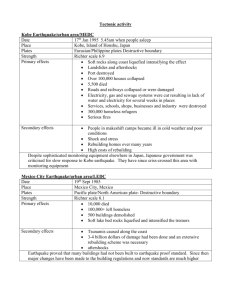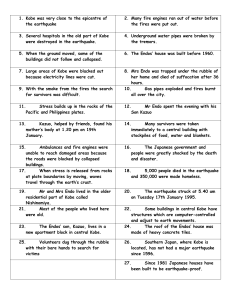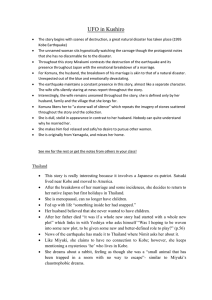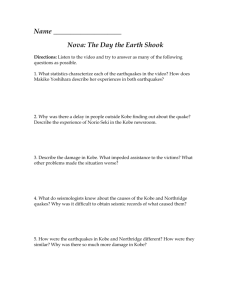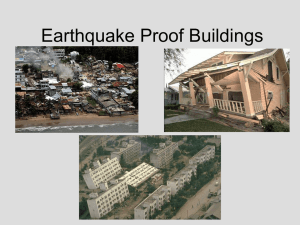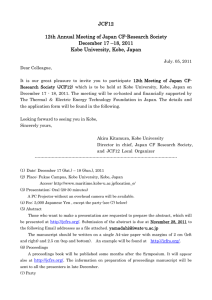DP The Long-Run Socio-Economic Consequences of a Large Disaster:
advertisement
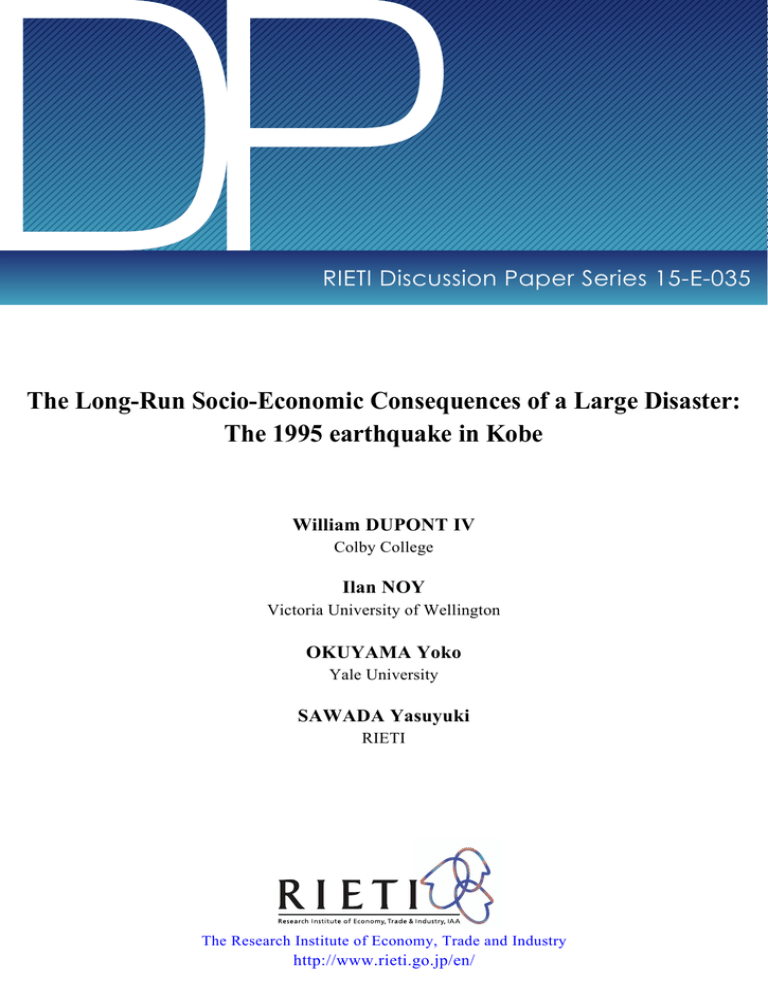
DP
RIETI Discussion Paper Series 15-E-035
The Long-Run Socio-Economic Consequences of a Large Disaster:
The 1995 earthquake in Kobe
William DUPONT IV
Colby College
Ilan NOY
Victoria University of Wellington
OKUYAMA Yoko
Yale University
SAWADA Yasuyuki
RIETI
The Research Institute of Economy, Trade and Industry
http://www.rieti.go.jp/en/
RIETI Discussion Paper Series 15-E-035
March 2015
The Long-Run Socio-Economic Consequences of a Large Disaster:
The 1995 earthquake in Kobe *
William DUPONT IV
Ilan NOY
Colby College
Victoria University of Wellington
OKUYAMA Yoko
SAWADA Yasuyuki †
Yale University
University of Tokyo and RIETI
Abstract
In this study, we aim at quantifying the permanent socio-economic impacts of the Great Hanshin-Awaji
(Kobe) Earthquake in 1995. We employ a large scale panel data of 1,719 wards (shi, ku, cho, son) from Japan
over almost three decades. In order to overcome a fundamental difficulty of obtaining a clean control group,
i.e., the Kobe economy without the earthquake, we adopt the synthetic control method of Abadie et al. (2010).
Three important empirical findings emerged from our empirical analyses. First, the income level and the
population size of the Kobe economy have been significantly lower than the counterfactual level without the
earthquake over 15 years, indicating a significant permanent negative effect of the earthquake. Such a negative
impact can be found especially in the central areas such as Chuo, Hyogo, and Nagata wards in Kobe, which
are close to the epicenter. Second, the surrounding areas such as the city of Nishinomiya encountered positive
permanent impacts with short-run negative effects of the earthquake. Third, the relatively outside areas such as
the north (kita) wards of Kobe, the city of Akashi, and the city of Himeji seem to be insulated from the large
direct and indirect impacts of the earthquake. In sum, there seem to be significant heterogeneities of the
short-run and long-run losses caused by the earthquake even within the affected areas, suggesting that
different market and non-market mechanisms function significantly to weather the impact of the earthquake
spatially.
Keywords: Great Hanshin, Long-term impact, Synthetic control method, Ward-level data, Heterogeneities in
damages
JEL classification: O11, Q54, R11
RIETI Discussion Papers Series aims at widely disseminating research results in the form of professional
papers, thereby stimulating lively discussion. The views expressed in the papers are solely those of the
authors, and neither represent those of the organization to which the authors belongs nor the Research
Institute of Economy, Trade and Industry.
*
This research is a part of the project “Post-disaster Recovery Policies and Insurance Mechanisms
against Disasters: Case Studies on Earthquakes in Japan and Floods in Thailand” undertaken at the Research Institute of
Economy, Trade & Industry (RIETI). The authors would like to thank RIETI for generous support for the project. The
authors are also grateful for their helpful suggestions and comments from the seminar participants at RIETI – in
particular, Atsushi Nakajima, Masahisa Fujita, Masayuki Morikawa and Hiroyuki Nakata. Noy’s work was partly funded
by a grant from the National Oceanic and Atmospheric Administration, Project R/IR-22, which is sponsored by the
University of Hawaii Sea Grant College Program under Institutional Grant No.NA09OAR4170060. The opinions
expressed and arguments employed in this paper are the sole responsibility of the authors and do not necessarily reflect
those of RIETI or the Ministry of Economy, Trade and Industry of Japan or NOAA and any of its sub-agencies.
†
Yasuyuki Sawada (Corresponding Author): Faculty of Economics, the University of Tokyo. 7-3-1 Hongo, Bunkyo-ku,
Tokyo 113-0033, Japan. Phone: +81(3) 5841-5572; and Fax: +81 (3) 5841-5521 (email: sawada@e.u-tokyo.ac.jp).
1
1. Introduction
The Great Hanshin-Awaji earthquake (hereafter, the Kobe earthquake) struck at 5:46 a.m. on
January 17, 1995, on Awaji Island offshore from the city of Kobe, affecting an area that was, at
the time, home to 4 million people and that contained one of Japan’s main industrial clusters.
The earthquake, which had registered 7.3 on the Richter scale, cost 6,432 lives, resulted in
43,792 injured, and damaged 639,686 buildings, of which 104,906 were completely destroyed.
The Kobe earthquake was responsible for one of the largest direct economic losses due to a
natural hazard in recorded human history. 1 While we understand well the direct impact of the
Kobe earthquake, we know much less about its impacts in the long-term. Surveys suggest that
the people of Kobe experienced a prolonged and significant adverse impact on their well-being
(1). However, did the Kobe earthquake in 1995 indeed cause permanent losses to the economies
of Kobe and other surrounding areas in Japan? Or is the recorded sense of deteriorating
well-being need to be explained through mechanisms other than a real decline in the economic
circumstances of the region?
The received wisdom appears to be that the devastation wrought by the 1995 Kobe earthquake
did not have any long-term impact on the Japanese economy, nor much impact on Kobe itself
(2), though some recent work disputes these conclusions (e.g., 3). The answer to this question
should be based on a comparison between the actual realized Kobe economy, and a
counter-factual Kobe without the earthquake. The conventional approach has been to compare
the development of post-quake Kobe with the trends observed in Japan (excluding Kobe; e.g., 4).
However, such an approach raises questions about the arbitrariness of selection and the degree
to which the comparison unit (Japan excluding Kobe) is indeed a credible proxy for the
treatment unit’s counterfactual (Kobe without an earthquake). This difficulty is compounded by
the fact that the earthquake occurred a few years after Japan had already entered the “lost
decade”— a prolonged recession following the collapse of the housing market circa 1990. The
synthetic control method we adopt here, introduced by Abadie and Gardeazabal (6) and
formalized in Abadie et al. (7 & 8 – henceforth ADH), overcomes these shortcomings by
adopting a data-driven control-group selection procedure. The counter-factual observations are
synthetically constructed as a weighted average of available control units that were not affected
so that this synthetic control approximates the most relevant characteristics of the treated unit
prior to the treatment.
1
The total amount of loss caused by the Great East-Japan earthquake on March 11, 2011, seems to be the
largest in human history (5).
Recently, (9) and (10), using different methodologies and prefecture (province/state) level data,
reach opposing conclusions. Neither, however, can explain their findings, as the analysis of
prefecture level data masks dramatic heterogeneities in damages within Hyogo prefecture in the
amount of direct losses with much of the prefecture unaffected but Kobe City and surrounding
areas dramatically damaged. Equally, we would expect significant heterogeneities in the
long-term indirect impacts. In order for us to adequately establish a counterfactual, provide
details of the heterogeneous ways in which the economy of the region was impacted, and
describe the mechanisms that led to these long-term effects, we employ a large panel data of
Japanese wards (districts/counties) observed annually for over three decades (1980-2010). We
conclude by putting our findings in the context of the (scant) literature on the long-term impact
of environmental shocks and discusses the likely causal mechanisms.
2. Data & Method
For all Japanese wards, we obtain information on 67 variables, so that our dataset is constructed
from 1,763,153 observations. 2 The synthetic control methodology requires that each predictor
variable have at least one observation associated with each control unit during the pretreatment
period. The methodology requires that each unit of observation in the pool of possible controls
be unaffected by the treatment. We removed all cities, towns, and wards in both Hyogo and
Osaka Prefectures so that all wards in all other prefectures are used as potential counterfactual
controls. Between 1980 and 2010 there were 719 mergers between cities, towns, and wards.
This, together with missing observations, reduced our sample to 1719 wards.
2
“Basic Data of Cities, Towns, and Villages (shi ku cho son kiso data) of Statistics Bureau, Ministry of
Internal Affairs and Communications, available at: http://www.stat.go.jp/english/data/ssds/outline.htm.
For the full list of variables used in this paper, please see Appendix A. 16 of these variables, have issues
with missing data, such as Product Shipments, and could not be used as predictor variables. The
remaining 51 variables both served as predictor variables, as well as potential variables to check for
impact.
3
Figure 1: Wards in Hyogo Prefecture Selected for Analysis
4
We employ the synthetic control methodology to quantify the impact of the Kobe earthquake by
constructing a counterfactual from other Japanese wards that were subject to the same external
shocks and institutional and legal frameworks but have not directly experienced the earthquake.
Let Yit be the outcome variable for ward i, where we set i=1 for the treated wards and i>1 for the
other Japanese wards unaffected directly by the earthquake, at time t (=1, …, T0, …, T) where
T0=1994.
Y Iit
is the outcome variable in the presence of the earthquake and
Y Nit
is the
outcome variable had the earthquake not occurred.5 The model requires the assumption that the
event had no effect on the outcome variable before it occurred at time T0 + 1 (Y itI = Y itN∀t ≤ T 0) .
Although this last assumption is unjustified in cases where disaster impact is frequent and
therefore expected, Kobe had not experienced a similar event, and was widely perceived in
Japan as a low-earthquake-risk region.
The observed outcome is defined by Y it = Y Nit + α it Dit where
on the variable of interest
α it
is the effect of the disaster
(Y Iit − Y Nit ) and Dit is the binary indicator denoting the event
occurrence ( Dit =1 for t > T0 and
i = 1 ; and Dit =0 otherwise). The aim is to estimate α it
for all t > T0 for the affected wards/cities (i=1). The estimation problem is that for all t > T0 it
is not possible to observe Y 1tN (the counterfactual) but only Y 1tI .
Following ADH, suppose that
N
Y it
can be given by the following factor model:
N
δ t + θt Z i + λt µi + ε it , where Z i is a vector of observed covariates (variables such as
Y it =
regional product per capita, population, etc.)6 and µi is a vector of unknown factor loadings.
5
This description is a modified version of (7). To simplify comparison, we follow their notation where I
denotes intervention (event occurring) and N denotes non-intervention (event not occurring).
6
A full list of the additional variables we use can be found in the data appendix.
5
Let W = (ω2 ,..., ω J +1 )′ be a vector of weights allocated to the different (unaffected) ward/city
observations such that w j ≥ 0 for
=
j 2,..., J + 1 and
J +1
∑ω
j =2
j
= 1 . A synthetic control is a
weighted combination of the controls such that it replicates a treated unit as if the treatment had
not occurred. Thus the outcome variable for each synthetic control can be written
J +1
J +1
=j 2
=j 2
J +1
J +1
δ t + θt ∑ ω j Z j + λt ∑ ω j µ j + ∑ ω j ε jt
∑ ω jY jt =
(1)
=j 2=j 2
(ωˆ 2 ,..., ωˆ J +1 ) that
Suppose there is a set of estimated weights
can accurately replicate the
treated unit’s pre-treatment observations in the following manner
J +1
∑ ωˆ Y
j =2
j
J +1
j1
= Y11 ,…, ∑ ωˆ jY jT0 = Y1T0 and
j =2
J +1
∑ ωˆ Z
j =2
j
j
= Z1
(2)
Abadie et al. (2010) show that under acceptable assumptions, combining the previous equations
J +1
N
yields the following: Y1t = ∑ ωˆ jY jt . Furthermore they prove that this equality will hold for all
j =2
t
provided the number of pre-intervention periods is large enough. 7 In our case we have 15
periods of pre-disaster data, which is comparable to (7) and (8) using this method. We obtain an
estimate of the impact of treatment (the earthquake) as:
J +1
αˆ=
Y 1t − ∑ ωˆ jY jt
1t
j =2
for t > T0
(3)
Our goal is to select a set of weights for which (2) holds approximately. We determine the
appropriate weights by examining the goodness of fit over the pre-treatment period as well as
the predictor balance for all of the variables in Z1 . The set of weights W is selected to
minimize the distance between the predictor variables for the treated prefecture ( X 1 ) and those
of the synthetic control ( X 0W ) during the pretreatment period. We choose W such that the
following equation is minimized:
7
For the complete proof see (7) Appendix B.
6
X 1 − X 0W
V
= ( X 1 − X 0W )′ V ( X 1 − X 0W )
(4)
where V is some (k × k ) symmetric and positive semi-definite matrix. In this particular case
k is the number of explanatory variables. V is used to place weights on the predictor variables
such that the difference between the variable of interest for the treated prefecture ( Y1 ) and that
of the synthetic control ( Y0W ) is minimized during the pre-treatment period. We use the Synth
Package for R to obtain V such that the root mean squared prediction error (RMSPE) is
minimized for the period prior to the earthquake. For robustness, we use two different initial
values to obtain V and then use the best result as our final value.8 We only present, and map,
results for which the RMSPE ≤ 10%. 9 The motivation for the strict adherence to this
condition is that this tight fit establishes the robustness of our results. Our success (or lack
thereof) in establishing a counterfactual that successfully tracks the actual observations for the
treated units in the pre-treatment period is our main yardstick.
An alternative approach is to examine placebo impacts (impact assessment for geographical
units that did not, in reality, experienced the disaster – similarly to the placebo effect in medical
studies). This approach is, however, difficult in our case, given the very large dataset we are
using (much bigger than what was used in the previously cited papers by Abadie and
co-authors). The placebos we estimate are generally estimated fairly inaccurately (their
pre-event fit is low). We nevertheless include placebo results for our main variables of interest
in the attached appendix and discuss them in the text.
8
The R ‘synth’ package uses two starting values for the weights and then utilizes the Nelder-Mead and
BFGS algorithms to minimize the distance.
9
RMSPE ≡ �
2
�
𝑦 −𝑦
∑𝑡� 𝑡 𝑡 ×100� ×1{𝑡<1994}
�
𝑦𝑡
∑𝑡 1{𝑡<1994}
. We use t<1994 rather than t<1995 since the Earthquake occurred
on Jan.7, 1995 (fiscal year 1994).
7
3.
Results
We start by showing a few illustrative examples of the results we obtain, and follow with a set
of maps that summarize our results more comprehensively. In figures 2 and 3, we show the
impact of the earthquake on the population of Kobe City (aggregated over its wards), and for
another nearby city to the East of Kobe, Nishinomiya. These two figures show both the actual
observations for Kobe and Nishinomiya (black lines) over the whole sample period (1980-2010)
and the calculated synthetic counterfactual (grey line). The distance between the two lines is the
� 1𝑡 ).
calculated impact of the earthquake (∝
For Kobe City, we find permanent negative but small impact on total population: around 2%
decline in population 15 years after the earthquake, after an initial larger decline in the
immediate few years of the disaster’s aftermath (Figure 2). While we do not show these figures
separately, the permanent loss of population in Kobe City can be found for both males and
females. Nishinomiya, shown in figure 3, provides an illuminating contrast. After a sharp
decline in the immediate aftermath of the earthquake, a decline that was bigger than that
experienced in Kobe City, Nishinomiya ended up with population gain; the population 15 years
after the earthquake has increased by 10% relative to what it would have been had the
earthquake not occurred (Figure 3).
8
Figure 2: The Impact of the Earthquake on Population of Kobe City
1.2
1.15
1.1
1.05
1
0.95
0.9
0.85
0.8
1980
1985
1990
1995
Synthetic
2000
2005
2010
Kobe
Figure 3: The Impact of the Earthquake on Population of Nishinomiya City
1.2
1.15
1.1
1.05
1
0.95
0.9
0.85
0.8
1980
1985
1990
1995
Synthetic
2000
2005
2010
Nishinomiya
For Kobe’s population estimate, we make two observations from the placebo results: First, the
goodness-of-fit for Kobe’s population estimates pre-event is better than for most other cities in
our dataset. Second, the post-event trajectory of Kobe is not significantly outside the range of
estimates for other regions. This second observation suggests that the small identified impact on
9
Kobe’s population may not be statistically robust.
Figures 2 and 3 show the impact of the earthquake for only two geographical units. In order to
summarize the information included in the results for every impacted ward/town/city in the
region, we plot these on a map. We color every geographical unit with the estimated impact on
the variable of interest, calculated as the difference between the synthetic and the actual
observation for that region (as the distance between the two lines in figures 2 and 3, expressed
in percent); blue colors denote decreases and the reds denote increase. Only those results for
which the pre-event fit is sufficient (RMSPE<10; see footnote 7) are presented. These maps
allow us to observe more clearly the spatial patterns we found. In all figures, the top panel
presents our estimates using the city-level data. Thus, the impact plotted for Kobe City is
estimated for the city as a whole, using a control group composed of other Japanese cities. The
bottom panel provides more detail by focusing on differential impacts across the nine wards of
Kobe City; these impacts are estimated using the ward-level dataset.10
During the first year after the earthquake, there was a short-term dip in population across the
whole area nearest to the epicenter, and including the urban Eastern corridor toward Osaka. In
the longer-run, however, we observe heterogeneities in permanent population trends. Figures
available in the appendix present the population impact maps for the aggregate figures, and
disaggregated by gender and age and using several population measures from different sources.
In figure 4, we observe a pattern of movement away from the most severely affected areas.
However, regions to the east, that were also seriously impacted initially, seem to gain in long
10
In principle, the results presented in the top panel for Kobe City (city-level) can be thought of as a
weighted-average of the results from the bottom panel of each map (ward-level) – weighted by the
relative size of each ward. However, this is not exactly the case as the synthetic is estimated using a
different set of controls.
10
run, suggesting that proximity to Osaka may be a driver of population recovery. These patterns
are not uniform; Sumoto city, for example, which is located near the epicenter, has been largely
unaffected, implying that the community and industry employment characteristics matter as
well.
Figure 5 includes an examination of the day-time population of the area we examine. These
estimates suggest that there is a uniform and persistent decline of population even in the
longer-term. This decline in daytime population is even observed for these towns to the East, for
which we observed population increases in figure 4. This suggests that the increase in
population observed to the East of Kobe City is driven by people who have moved to these
areas from the devastated center, but have also switched their location of employment eastward
to Osaka.
Another intriguing trend, presented in figure 6, is the increase in the number of people over the
age of 65. When compared with other geographical units in Japan (the synthetic control), Kobe
City seemed to have gained more. While we do not know the exact reasons for this shift, we can
speculate that it may be associated with either people returning to their cultural roots (as the
impact of the earthquake leads to shifts in preferences), or that over-65, living mostly on fixed
incomes, are moving to a place where living costs are lower (both because of the relative
economic decline of the region and the generous government support).
For income, as we can see from Figure 7, Kobe City partially bounced back after the earthquake,
but there still appears to be a permanent loss in income. Again, we find intra-regional
heterogeneous variations in income recovery. While the areas East of Kobe seem to gain in long
11
run, other parts closer to central Kobe lost substantial amount of income, suggesting once more
that the proximity to Osaka as a new provider of employment and income may be a driver of the
(partial) economic recovery in Kobe’s Eastern region.
12
Figure 4: Total population
13
Figure 5: Daytime population
14
Figure 6: More than 65 year-old population
Figure 7: Taxable income
15
We next study aggregate unemployment (figure 8), and then employment in the secondary
(manufacturing) and tertiary (services) sectors in figures 9 and 10, respectively. 11 The evidence
on aggregate unemployment is quite clear. Unemployment increased, both in the short- and in
the long-term, and both in Kobe City itself, and in the peripheral towns. Remarkably, the
evidence seems to suggest a stronger adverse impact in the long-term (15 years after the
earthquake).
The secondary (manufacturing) sector in Kobe City declined both in the short- and long-terms;
this decline is observable in both the number of secondary-sector businesses operating in the
city, and the level of employment in this sector. The spatial distribution is quite different for the
tertiary sector (services). As before, we observe a short-term decline for Kobe City, its wards,
and the surrounding towns in both number of operating businesses and employment. However,
once we examine the longer-horizon, 15 years after the earthquake, we observe an increase in
the number of tertiary (services) businesses operating, accompanied by a smaller increase in
employment when evaluated against employment trends elsewhere in Japan. Essentially, it
appears that Kobe City experienced a shift from secondary to tertiary employment. This shift
may explain the declines in aggregate taxable income, and as the wages in service sector jobs
are typically lower than in the industrial/manufacturing sector.
11
Equivalent analysis of the number of businesses in the secondary and tertiary sectors is available in the
appendix.
16
Figure 8: Number of Unemployed
Figure 9: Number of employees in the secondary sector
17
Figure 10: Number of employees in the tertiary sector
4.
Conclusions, caveats, and future considerations
The three central empirical regularities that emerged from our synthetic control analysis are:
First, the income and to a lesser extent the population of Kobe City have both decreased. This
effect of the earthquake lasted for over fifteen years, indicating a significant permanent negative
impact. Such a negative impact can be found especially in the central area (e.g., Chuo, Hyogo,
and Nagata wards), which is closest to the epicenter of the earthquake. Second, the surrounding
areas, in particular East of Kobe (e.g., Nishinomiya city), experienced positive permanent
impacts after facing short-run negative effects in the immediate aftermath of the earthquake.
This positive impact however did not result in increased employment in this region; rather, this
region’s increased population is mostly employed in nearby Osaka (further to the East). Third,
the peripheral areas seem to have been insulated from the large direct and indirect impacts of the
earthquake.
18
Once the spatial and dynamic responses of each region, city and ward has been described, as we
have done here, the next research task is to identify the policy determinants of these differing
trajectories, and to further investigate whether possible policy shifts could have led to more
favorable outcomes. Instead of relying on the ward-level dataset we used, other alternative
sources of information and methodology may yield additional insights about the process of
recovery (or lack thereof) in Kobe post-1995, and especially on its policy determinants.
Two types of costs associated with disasters are especially important, the direct irreversible
costs、mostly mortality and morbidity, and the long-term or permanent costs, as they impose
large permanent impacts on human wellbeing in the affected regions. 12 Our results here suggest
that large catastrophic shocks, such as the 1995 Kobe earthquake, impose long-term/permanent
costs on the affected region. These costs are typically not clearly identified and are thus not
considered when assessing the benefits from disaster risk reduction and mitigation policies. This
failure leads to under-investment to reduce risks from disasters, and in trying to mitigate their
impacts. Maybe more importantly and less obviously, we also believe that this failure to
recognize the long-term permanent impacts leads to complacency during the post-disaster
recovery process itself. Policymakers and the public believe that recovery will be achieved, and
are thus mostly making policy and electoral decisions based on short-term considerations rather
than in an attempt to guide this long-term process to a more successful conclusion.
A different concern and motivation for our research agenda is the well-documented increasing
economic costs of natural disasters (e.g., 14), even if there is uncertainty regarding the reasons
12
The few papers that have examined long-term impacts of natural hazards include (11), (12) and (13).
19
for this trend. The socio-economic dynamics we investigated here are bound to become more
important in the future, even if some of the more dire predictions regarding the impact of
climate change on extreme climatic events do not materialize (15). Our publics, our
governments, our international organizations, and the international agreements and covenants
we agree on (most relevant is the Hyogo Framework for Action 13) must take into account these
long-term permanent impacts in guiding future actions.
13
The HFA, a 10 years agreement whose aim was “to make the world safer from natural hazards,” is to
expiring in 2015, and a new framework agreement is currently being negotiated.
20
References
Abadie A, Diamond A, Hainmueller J (2010) Synthetic control methods for comparative case
studies: Estimating the effect of California’s tobacco control program. Journal of the American
Statistical Association, 105(490).
Abadie A, Diamond A, Hainmueller J (2014) Comparative politics and the synthetic control
method.” American Journal of Political Science.
Abadie A, Gardeazabal J (2003) The Economic Costs of Conflict: A Case Study of the Basque
County. American Economic Review 93(1):112-132.
Beniya S (2007) The Evaluation of the Status of Disaster Areas by using Recovery Indicators in the case of the Great Hanshin-Awaji Earthquake. 2nd International Conference on Urban
Disaster Reduction.
Chang S (2010) Urban disaster recovery: a measurement framework and its application to the
1995 Kobe earthquake.” Disasters 34(2), 303-327.
Coffman M, Noy I (2012) Hurricane Iniki: Measuring the Long-Term Economic Impact of a
Natural Disaster Using Synthetic Control. Environment and Development Economics 17(2):
187-205.
DuPont W, Noy I (2014). What happened to Kobe? A reassessment of the impact of the 1995
earthquake in Japan. Economic Development and Cultural Change, forthcoming.
Fujiki, H, Hsiao C (2013) Disentangling the Effects of Multiple Treatments -Measuring the Net
Economic Impact of the 1995 Great Hanshin-Awaji Earthquake. Discussion Paper Series
13-E-03, Institute for Monetary and Economic Studies, Bank of Japan.
Hornbeck R, Naidu S (2014) When the Levee Breaks: Black Migration and Economic
Development in the American South. American Economic Review. 104(3): 963-90.
Hornbeck R (2012). The Enduring Impact of the American Dust Bowl: Short- and Long-Run
Adjustments to Environmental Catastrophe. American Economic Review, 102(4): 1477–1507.
Horwich G (2000) Economic lessons of the Kobe earthquake. Economic development and
cultural change, 48(3), 521-542. IPCC (2012) ‘Managing the Risks of Extreme Events and
Disasters to Advance Climate Change Adaptation’, A Special Report of Working Groups I and
II of the Intergovernmental Panel on Climate Change.
Ohtake F, Okuyama N, Sasaki M, Yasui K (2012) Measuring the long-lasting effect of natural
disasters: The case of the 1995 Hanshin–Awaji Earthquake.” Paper presented at the East-West
Center, December.Sawada Y, Shimizutani S (2011). Changes in durable stocks, portfolio
allocation, and consumption expenditure in the aftermath of the Kobe earthquake. Review of
Economics of the Household, 9(4), 429-443.
UNISDR (2013) Global Assessment Report on Disaster Risk Reduction. Geneva, Switzerland:
United Nations Office for Disaster Risk Reduction.
21
Additional figures available in appendix
Contents
Page No.
Figure 1.
A1001 The total number of the population
3
Figure 2.
A1076 More than 65 year-old total population
4
Figure 3.
C1352 Population in register – Total
5
Figure 4.
C1353 Population in register – Male
6
Figure 5.
C1354 Population in register – Female
7
Figure 6.
C1495 Day time population
8
Figure 7.
Impact on Taxpayer Income in Kobe City
9
Figure 8.
Impact on Taxpayer Income in Nishinomiya City
9
Figure 9.
Impact on Taxpayer Income in Yokohama City
10
Figure 10.
C1632 Taxable income
10
Figure 11.
C1633 Number of taxpayers
11
Figure 12.
C1690 Number of the secondary industry businesses
12
Figure 13.
C1691 Number of tertiary sector businesses
13
Figure 14.
C1724 Number of employees in the secondary sector
14
Figure 15.
C1725 Number of employees in the tertiary sector
15
Figure 16.
F2655 Number of Unemployed in Kobe
16
Figure 17.
F2655 Number of Unemployed
17
Figure 18.
Placebos for Registered Population (all cities)
18-28
Figure 19.
Placebos for Taxable Income
29-39
Table 1.
Kobe Population (A1352) Predictor Means
40-41
Table 2.
Data sources
42-44
Appendix.
Impacts on Each Variable in Each Ward
45-51
22
